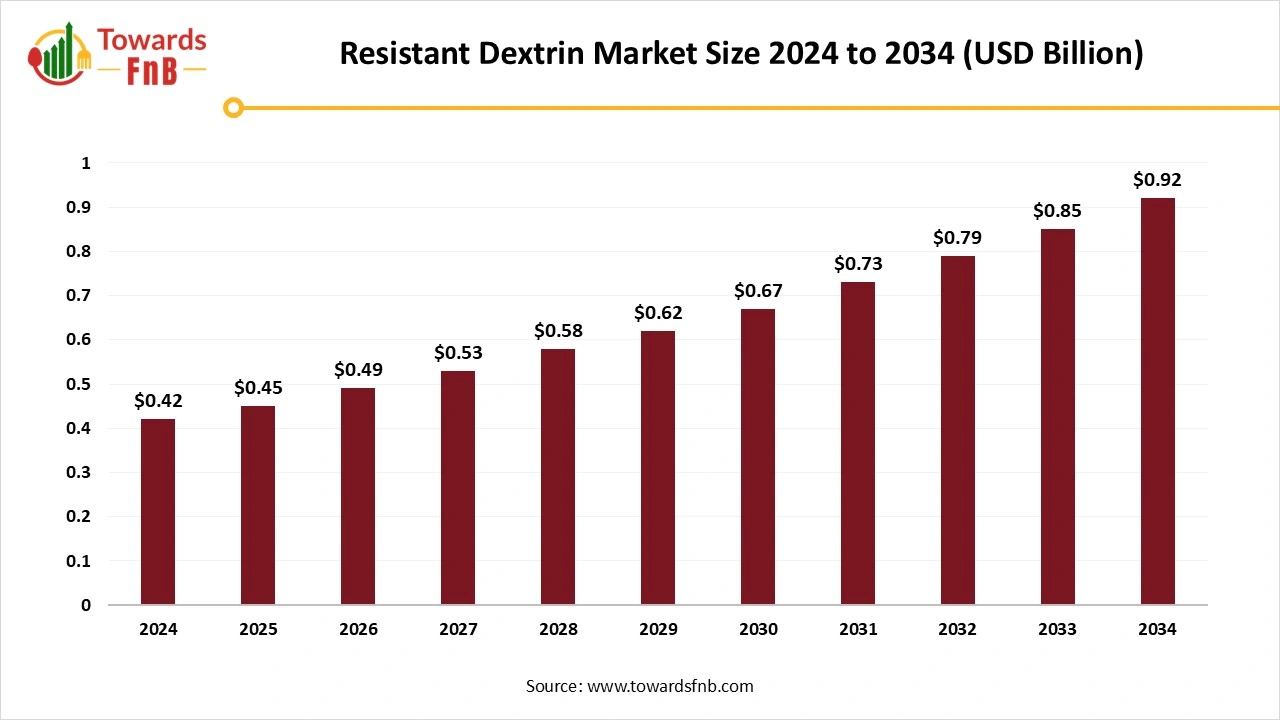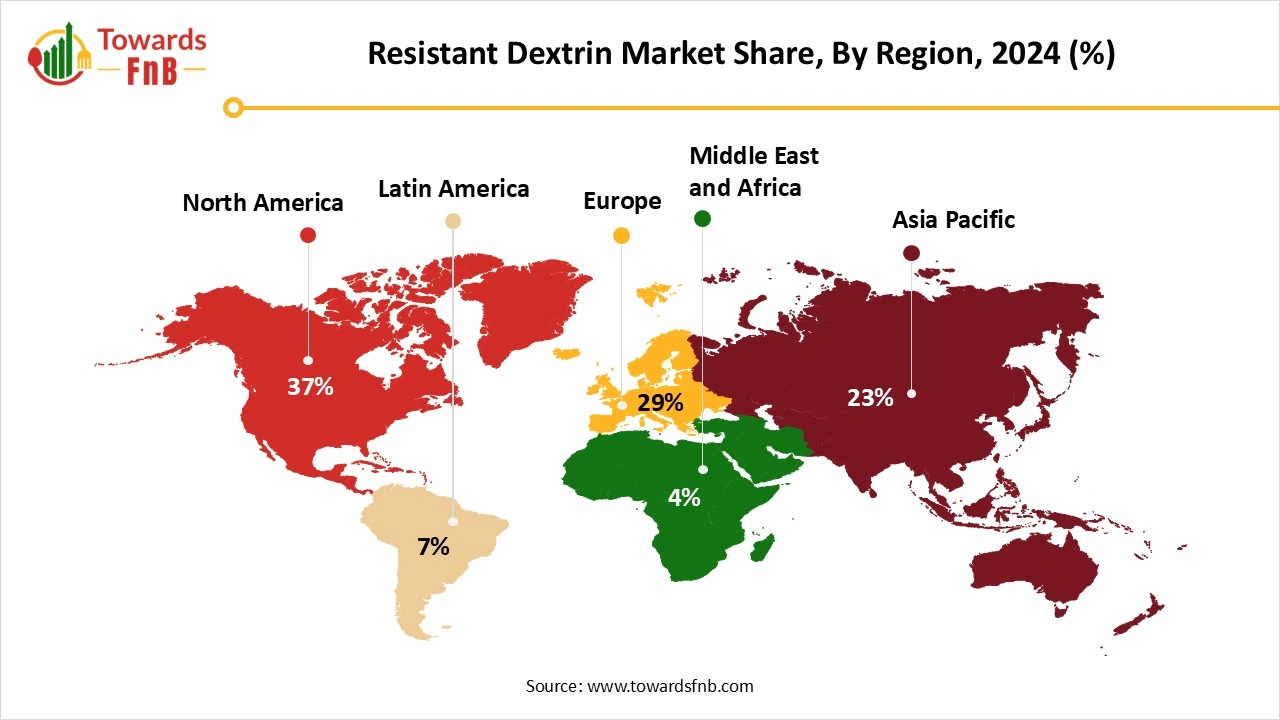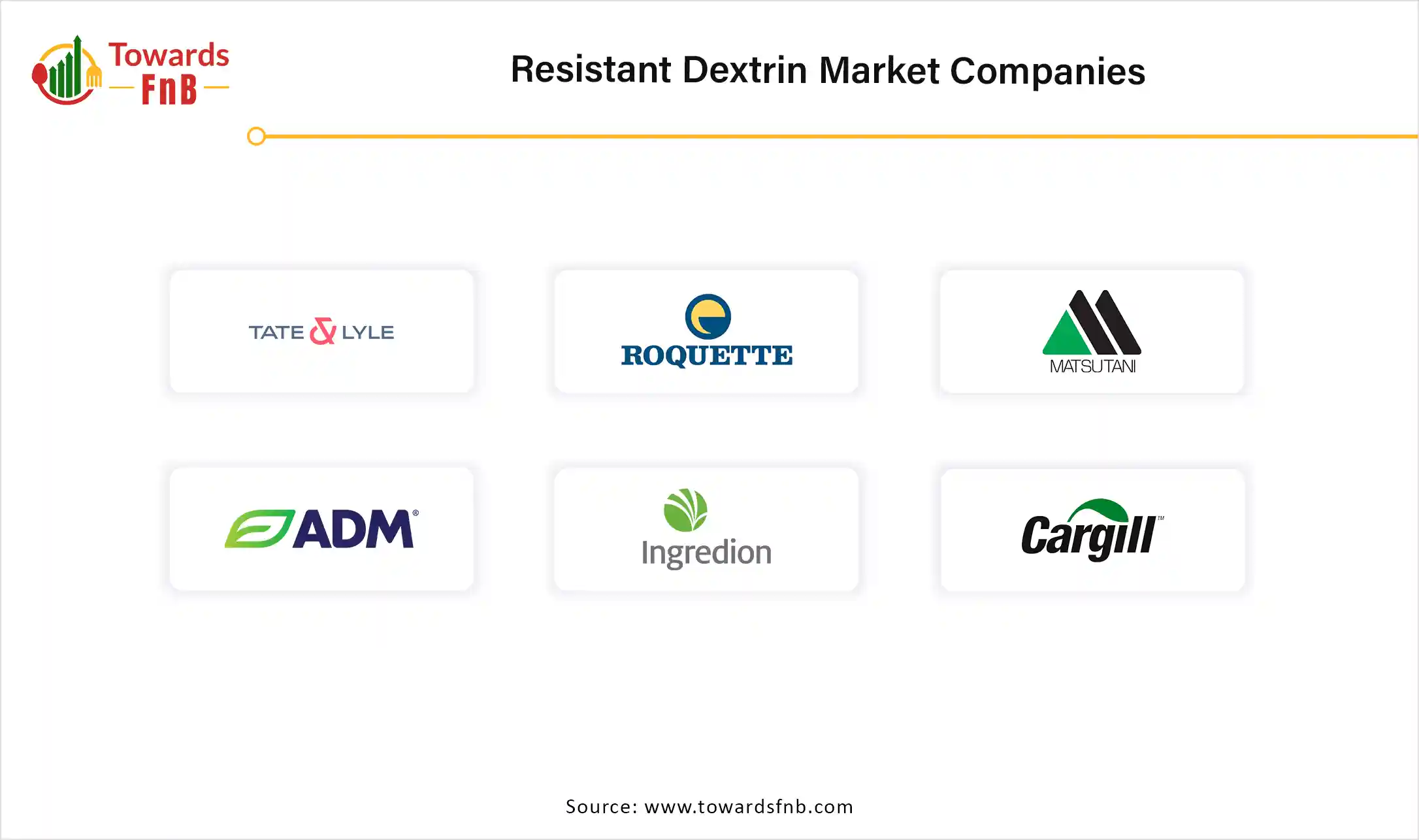November 2025
The global resistant dextrin market size was reached at USD 0.42 billion in 2024 and is expected to rise from USD 0.45 billion in 2025 to nearly reaching USD 0.92 billion by 2034, growing at a CAGR of 8.2% during the forecast period from 2025 to 2034. The increased preference for healthy diets supports the global expansion of carbohydrates and other healthy ingredients.

| Study Coverage | Details |
| Growth Rate from 2025 to 2034 | CAGR of 8.2% |
| Market Size in 2025 | USD 0.45 Billion |
| Market Size in 2026 | USD 0.49 Billion |
| Market Size by 2034 | USD 0.92 Billion |
| Largest Market | North America |
| Base Year | 2024 |
| Forecast Period | 2025 to 2034 |
| Regions Covered | North America, Europe, Asia-Pacific, Latin America, and Middle East & Africa |
Resistant dextrin is a type of soluble dietary fiber derived from starch that resists digestion in the small intestine and reaches the colon where it acts as a prebiotic. It is colorless, tasteless, and has excellent solubility, making it ideal for use in a variety of food and beverage products for its fiber enrichment, blood glucose control, and gut health benefits.
Manufacturers focus on adhering to strict quality control measures by ensuring the safety and quality of organic-resistant dextrin. They are enabled to do regular testing for purity, fiber content, and solubility. These products also meet safety standards set by regulatory bodies such as the U.S. Food and Drug Administration (FDA) and EFSA. These standards ensure food safety for consumption and the absence of contaminants.
It is necessary to adhere strictly to the purity guidelines during the production of organically resistant dextrin. There must be compliance with strict organic standards for every step of the manufacturing process, including sourcing raw materials and packaging.
How North America Dominated the Resistant Dextrin Market in 2024?
North America dominated the resistant dextrin market in 2024 with a market share of 37% owing to government initiatives across this region. The administration of the U.S. Sugar Program by the U.S. Department of Agriculture supports domestic sugar production with the help of tools to limit the supply of sugar. The U.S. Federal Register introduced the Child Nutrition Program to keep consistent meal patterns based on 2020-2025 dietary guidelines for Americans. The New York City (NYC) Health Department introduced the national salt and sugar reduction initiative (NSSRI) through partnerships between organizations and health authorities from across the country.

How does the U.S. Implement General Food Safety Policies and Government Initiatives?
The U.S. Department of Agriculture (USDA) and the U.S. Department of Health and Human Services made efforts to provide dietary guidelines for Americans. These initiatives are supported by the Office of Disease Prevention and Health Promotion. They allow and promote healthy eating and physical fitness. In May 2024, the U.S. Department of Agriculture (USDA), Agricultural Research Service (ARS) organized the national program on food safety. It also conducted the national organic program and introduced the national organic standards board. The government took initiatives to reduce the use of pesticides.
Asia Pacific is expected to grow at the fastest CAGR in the resistant dextrin market during the forecast period. The region is adopting sugar-reduction trends for sauces and noodles by addressing the shift of consumers towards healthy food choices. The industries are focusing on different product formulations without affecting taste and functionality. The World Health Organization (WHO) focuses on promoting healthy food initiatives by addressing the rising incidence of obesity, diabetes, and other health complications in the world. The Asian Pacific governments are dedicated to introducing sugar taxes, nutri-grade labeling, public awareness campaigns, and promoting healthy alternatives.
How Singapore Drives its Government Regulations for Food Safety and Disease Management?
Singapore faces a significant health challenge due to the rising prevalence of diabetes and public health initiatives. The major rationales behind this challenge are high intake of sugary drinks, an aging population, and sedentary lifestyles. The Singaporean government introduced various policies for the regulation of sugar content in beverages and promoted healthy dietary choices. There are major public health initiatives, including public education campaigns and nutri-grade policies across the country.
How Corn (Maize-Based) Segment Dominated the Resistant Dextrin Market in 2024?
The corn (maize-based) segment dominated the market in 2024 owing to the health benefits of corn, such as improved eye health, supply of essential amino acids, and support for a gluten-free diet. The intake of corn fortifies bone density, keeps blood sugar levels in control, treats anemia, and boosts nervous system function. It also improves heart health, ensures a healthy pregnancy, contributes to healthy weight gain, promotes gut health, and treats hypertension. The consumption of corn has therapeutic applications such as lowering high blood pressure, treating liver dysfunction, and treating depression symptoms. It offers anti-aging effects, cures hyperpigmentation, prevents hair fall, and reduces acne and boils.
The tapioca segment is expected to grow at the fastest CAGR in the resistant dextrin market during the forecast period. Due to increasing demand for non-GMO and gluten-free options. Consumers have different choices for buying various forms of tapioca, such as tapioca meal, tapioca flakes, and tapioca syrup. It is low in allergens, easy for gut health, and a healthy choice for heart health.
What Made Powder the Dominant Segment in the Resistant Dextrin Market in 2024?
The powder segment dominated the market in 2024 owing to the benefits of powder forms of resistant dextrin, such as blood sugar regulation, improved gut health, and weight management. The powder forms offer improved nutrient absorption, reduced cholesterol levels, reduced waste, and energy efficiency.
The liquid segment is expected to grow at the fastest CAGR in the resistant dextrin market during the predicted timeframe. Due to preferred in beverage formulations and easier integration in ready-to-drink products. The liquid forms of dextrin are good for digestive health by delivering prebiotic effects and improved bowel movements.
How did the Food and Beverages Segment Dominate the Resistant Dextrin Market in 2024?
The food and beverages segment dominated the market in 2024 owing to the benefits of low-calorie-resistant dextrin in food and beverage products, which include a diabetic-friendly nature, and support in weight management and digestive health. The F&B products with resistant dextrin also offer manufacturing benefits such as versatility in formulations and cost efficiency. The popular beverages, snacks, and sauces such as diet soft-drinks and functional beverages get benefits from the inclusion of resistant dextrin.
The Functional Beverages Segment Held the Largest Share as a Sub-Segment in the Resistant Dextrin Market During the Forecast Period. Due to the rising demand for gut health and energy drinks with fiber content. The presence of resistant dextrin in functional beverages adds dietary fiber to protein shakes, smoothies, and fortified waters. These products support healthy consumer choices by aligning with market trends and promoting transparent labeling.
How Dietary Fiber Enrichment Segment Dominated the Resistant Dextrin Market in 2024?
The dietary fiber enrichment segment dominated the market in 2024 owing to the major role of low-sugar-resistant dextrin as a dietary fiber with less than 2% sugar. This innovative ingredient enabled the production of low-calorie and high-fiber products to meet modern consumer needs. It has revolutionized the food and beverage industry by focusing on the nutrition and the well-being of consumers.
The prebiotic support segment is expected to grow at the fastest CAGR in the resistant dextrin market during the predicted timeframe. Tied to increasing awareness of gut microbiome health. These products having prebiotic support exhibit high-quality, custom solutions, and offer sustainability.
What made B2B (Ingredient Sales to Manufacturers) the Dominant Segment in the Resistant Dextrin Market in 2024?
The B2B (ingredient sales to manufacturers) segment dominated the resistant dextrin market in 2024 owing to the major role of resistant dextrin for the manufacturers in terms of enhanced nutritional profile, improved texture, and increased shelf life. These products are cost-effective, clean-label-friendly, production efficient, and hold regulatory approvals.
The online platforms segment is seen to grow rapidly as a sub-segment in the market during the forecast period. Driven by the surge in direct-to-consumer supplement sales. Online platforms can promote the importance of gut health and boost immunity through the intake of healthy ingredients. The online platforms provide accessible information to consumers with scientific proof by using a clear and concise language.
How did the Food and Beverage Manufacturers Segment Dominate the Resistant Dextrin Market in 2024?
The food and beverage manufacturers segment dominated the market in 2024 owing to the increased focus of these manufacturers on producing food products that regulate intestinal function, help in weight management, and hold prebiotic properties. A diverse range of food products, such as confectionery, beverages, dairy products, baked goods, functional foods, etc. produced by manufacturers deliver various applications in the food and beverage industry.
The Nutraceutical Companies Segment is Expected to Grow at the Fastest CAGR in the Resistant Dextrin Market During the Predicted Timeframe. Due to rapidly introducing gut health and fiber-centric SKUs. The resistant dextrin products for nutraceutical companies offer several benefits, such as enhanced digestive health, blood sugar regulation, versatile ingredients, etc. They support weight management, reduce the risk of chronic diseases, and improve nutrient absorption.
ADM
ADM and Pyco Industries
Ingredion

By Source
By Form
By Application
By Functionality
By Distribution Channel
By End-User Industry
By Region
The global duck meat market size is rising from USD 3.40 billion in 2025 to USD 5.89 billion by 2034. This projected expansion reflects a compound ann...
The global protein hydrolysate market size is projected to expand from USD 3.76 billion in 2025 to USD 6.27 billion by 2034, growing at a CAGR of 5.85...
The global carbonated beverages market size is expected to register at a CAGR of 6.5%, growing from USD 654.98 million in 2025 to USD 1,154.44 million...
The global AI in coffee production market size is forecasted to expand from USD 324.88 million in 2025 to USD 1,474.28 million by 2034, growing at a C...
November 2025
November 2025
November 2025
November 2025